Jena D. Hwang
AstaBench: Rigorous Benchmarking of AI Agents with a Scientific Research Suite
Oct 24, 2025Abstract:AI agents hold the potential to revolutionize scientific productivity by automating literature reviews, replicating experiments, analyzing data, and even proposing new directions of inquiry; indeed, there are now many such agents, ranging from general-purpose "deep research" systems to specialized science-specific agents, such as AI Scientist and AIGS. Rigorous evaluation of these agents is critical for progress. Yet existing benchmarks fall short on several fronts: they (1) fail to provide holistic, product-informed measures of real-world use cases such as science research; (2) lack reproducible agent tools necessary for a controlled comparison of core agentic capabilities; (3) do not account for confounding variables such as model cost and tool access; (4) do not provide standardized interfaces for quick agent prototyping and evaluation; and (5) lack comprehensive baseline agents necessary to identify true advances. In response, we define principles and tooling for more rigorously benchmarking agents. Using these, we present AstaBench, a suite that provides the first holistic measure of agentic ability to perform scientific research, comprising 2400+ problems spanning the entire scientific discovery process and multiple scientific domains, and including many problems inspired by actual user requests to deployed Asta agents. Our suite comes with the first scientific research environment with production-grade search tools that enable controlled, reproducible evaluation, better accounting for confounders. Alongside, we provide a comprehensive suite of nine science-optimized classes of Asta agents and numerous baselines. Our extensive evaluation of 57 agents across 22 agent classes reveals several interesting findings, most importantly that despite meaningful progress on certain individual aspects, AI remains far from solving the challenge of science research assistance.
Intentionally Unintentional: GenAI Exceptionalism and the First Amendment
Jun 05, 2025Abstract:This paper challenges the assumption that courts should grant First Amendment protections to outputs from large generative AI models, such as GPT-4 and Gemini. We argue that because these models lack intentionality, their outputs do not constitute speech as understood in the context of established legal precedent, so there can be no speech to protect. Furthermore, if the model outputs are not speech, users cannot claim a First Amendment speech right to receive the outputs. We also argue that extending First Amendment rights to AI models would not serve the fundamental purposes of free speech, such as promoting a marketplace of ideas, facilitating self-governance, or fostering self-expression. In fact, granting First Amendment protections to AI models would be detrimental to society because it would hinder the government's ability to regulate these powerful technologies effectively, potentially leading to the unchecked spread of misinformation and other harms.
Ai2 Scholar QA: Organized Literature Synthesis with Attribution
Apr 15, 2025Abstract:Retrieval-augmented generation is increasingly effective in answering scientific questions from literature, but many state-of-the-art systems are expensive and closed-source. We introduce Ai2 Scholar QA, a free online scientific question answering application. To facilitate research, we make our entire pipeline public: as a customizable open-source Python package and interactive web app, along with paper indexes accessible through public APIs and downloadable datasets. We describe our system in detail and present experiments analyzing its key design decisions. In an evaluation on a recent scientific QA benchmark, we find that Ai2 Scholar QA outperforms competing systems.
DataDecide: How to Predict Best Pretraining Data with Small Experiments
Apr 15, 2025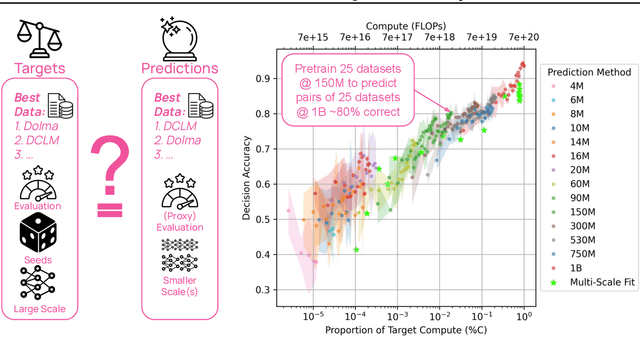
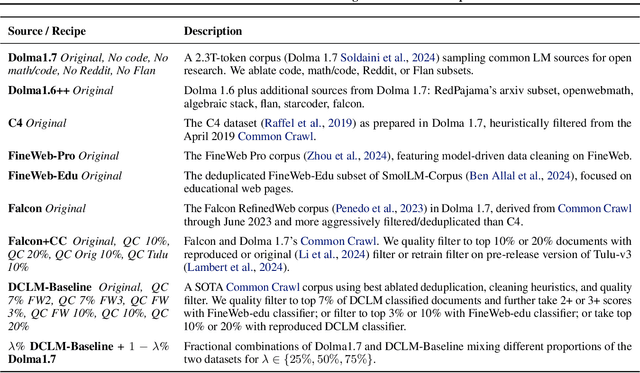
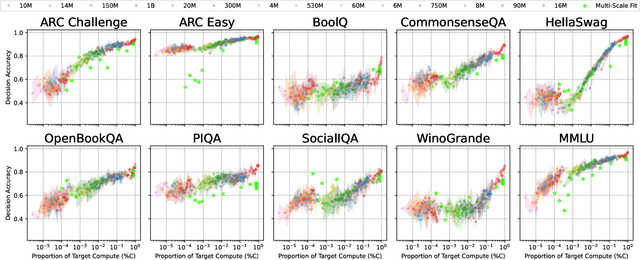
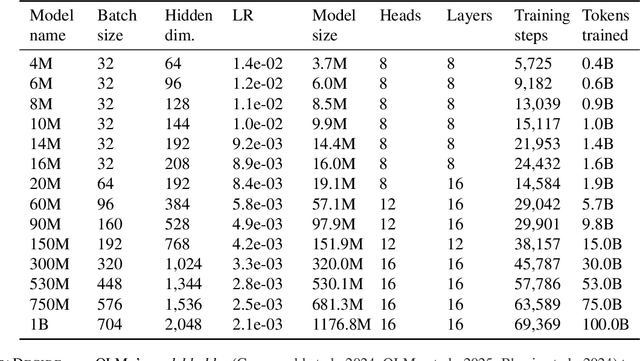
Abstract:Because large language models are expensive to pretrain on different datasets, using smaller-scale experiments to decide on data is crucial for reducing costs. Which benchmarks and methods of making decisions from observed performance at small scale most accurately predict the datasets that yield the best large models? To empower open exploration of this question, we release models, data, and evaluations in DataDecide -- the most extensive open suite of models over differences in data and scale. We conduct controlled pretraining experiments across 25 corpora with differing sources, deduplication, and filtering up to 100B tokens, model sizes up to 1B parameters, and 3 random seeds. We find that the ranking of models at a single, small size (e.g., 150M parameters) is a strong baseline for predicting best models at our larger target scale (1B) (~80% of com parisons correct). No scaling law methods among 8 baselines exceed the compute-decision frontier of single-scale predictions, but DataDecide can measure improvement in future scaling laws. We also identify that using continuous likelihood metrics as proxies in small experiments makes benchmarks including MMLU, ARC, HellaSwag, MBPP, and HumanEval >80% predictable at the target 1B scale with just 0.01% of the compute.
TÜLU 3: Pushing Frontiers in Open Language Model Post-Training
Nov 22, 2024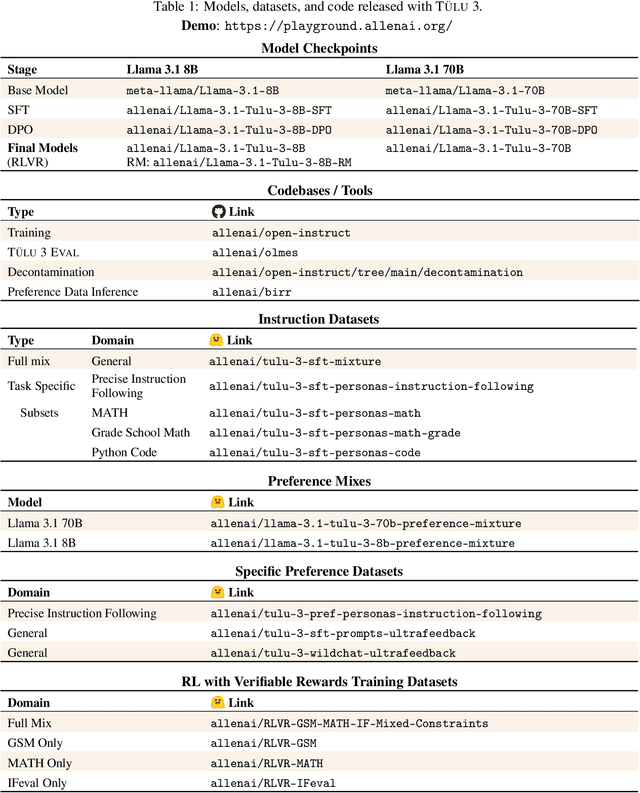



Abstract:Language model post-training is applied to refine behaviors and unlock new skills across a wide range of recent language models, but open recipes for applying these techniques lag behind proprietary ones. The underlying training data and recipes for post-training are simultaneously the most important pieces of the puzzle and the portion with the least transparency. To bridge this gap, we introduce T\"ULU 3, a family of fully-open state-of-the-art post-trained models, alongside its data, code, and training recipes, serving as a comprehensive guide for modern post-training techniques. T\"ULU 3, which builds on Llama 3.1 base models, achieves results surpassing the instruct versions of Llama 3.1, Qwen 2.5, Mistral, and even closed models such as GPT-4o-mini and Claude 3.5-Haiku. The training algorithms for our models include supervised finetuning (SFT), Direct Preference Optimization (DPO), and a novel method we call Reinforcement Learning with Verifiable Rewards (RLVR). With T\"ULU 3, we introduce a multi-task evaluation scheme for post-training recipes with development and unseen evaluations, standard benchmark implementations, and substantial decontamination of existing open datasets on said benchmarks. We conclude with analysis and discussion of training methods that did not reliably improve performance. In addition to the T\"ULU 3 model weights and demo, we release the complete recipe -- including datasets for diverse core skills, a robust toolkit for data curation and evaluation, the training code and infrastructure, and, most importantly, a detailed report for reproducing and further adapting the T\"ULU 3 approach to more domains.
Diverging Preferences: When do Annotators Disagree and do Models Know?
Oct 18, 2024



Abstract:We examine diverging preferences in human-labeled preference datasets. We develop a taxonomy of disagreement sources spanning 10 categories across four high-level classes -- task underspecification, response style, refusals, and annotation errors. We find that the majority of disagreements are in opposition with standard reward modeling approaches, which are designed with the assumption that annotator disagreement is noise. We then explore how these findings impact two areas of LLM development: reward modeling and evaluation. In our experiments, we demonstrate how standard reward modeling methods, like the Bradley-Terry model, fail to differentiate whether a given preference judgment is the result of unanimous agreement among annotators or the majority opinion among diverging user preferences. We also find that these tendencies are also echoed by popular LLM-as-Judge evaluation methods, which consistently identify a winning response in cases of diverging preferences. These findings highlight remaining challenges in LLM evaluations, which are greatly influenced by divisive features like response style, and in developing pluralistically aligned LLMs. To address these issues, we develop methods for identifying diverging preferences to mitigate their influence on evaluation and training.
Rel-A.I.: An Interaction-Centered Approach To Measuring Human-LM Reliance
Jul 10, 2024Abstract:The reconfiguration of human-LM interactions from simple sentence completions to complex, multi-domain, humanlike engagements necessitates new methodologies to understand how humans choose to rely on LMs. In our work, we contend that reliance is influenced by numerous factors within the interactional context of a generation, a departure from prior work that used verbalized confidence (e.g., "I'm certain the answer is...") as the key determinant of reliance. Here, we introduce Rel-A.I., an in situ, system-level evaluation approach to measure human reliance on LM-generated epistemic markers (e.g., "I think it's..", "Undoubtedly it's..."). Using this methodology, we measure reliance rates in three emergent human-LM interaction settings: long-term interactions, anthropomorphic generations, and variable subject matter. Our findings reveal that reliance is not solely based on verbalized confidence but is significantly affected by other features of the interaction context. Prior interactions, anthropomorphic cues, and subject domain all contribute to reliance variability. An expression such as, "I'm pretty sure it's...", can vary up to 20% in reliance frequency depending on its interactional context. Our work underscores the importance of context in understanding human reliance and offers future designers and researchers with a methodology to conduct such measurements.
Relying on the Unreliable: The Impact of Language Models' Reluctance to Express Uncertainty
Jan 12, 2024Abstract:As natural language becomes the default interface for human-AI interaction, there is a critical need for LMs to appropriately communicate uncertainties in downstream applications. In this work, we investigate how LMs incorporate confidence about their responses via natural language and how downstream users behave in response to LM-articulated uncertainties. We examine publicly deployed models and find that LMs are unable to express uncertainties when answering questions even when they produce incorrect responses. LMs can be explicitly prompted to express confidences, but tend to be overconfident, resulting in high error rates (on average 47%) among confident responses. We test the risks of LM overconfidence by running human experiments and show that users rely heavily on LM generations, whether or not they are marked by certainty. Lastly, we investigate the preference-annotated datasets used in RLHF alignment and find that humans have a bias against texts with uncertainty. Our work highlights a new set of safety harms facing human-LM interactions and proposes design recommendations and mitigating strategies moving forward.
SPLAIN: Augmenting CybersecurityWarnings with Reasons and Data
Nov 19, 2023Abstract:Effective cyber threat recognition and prevention demand comprehensible forecasting systems, as prior approaches commonly offer limited and, ultimately, unconvincing information. We introduce Simplified Plaintext Language (SPLAIN), a natural language generator that converts warning data into user-friendly cyber threat explanations. SPLAIN is designed to generate clear, actionable outputs, incorporating hierarchically organized explanatory details about input data and system functionality. Given the inputs of individual sensor-induced forecasting signals and an overall warning from a fusion module, SPLAIN queries each signal for information on contributing sensors and data signals. This collected data is processed into a coherent English explanation, encompassing forecasting, sensing, and data elements for user review. SPLAIN's template-based approach ensures consistent warning structure and vocabulary. SPLAIN's hierarchical output structure allows each threat and its components to be expanded to reveal underlying explanations on demand. Our conclusions emphasize the need for designers to specify the "how" and "why" behind cyber warnings, advocate for simple structured templates in generating consistent explanations, and recognize that direct causal links in Machine Learning approaches may not always be identifiable, requiring some explanations to focus on general methodologies, such as model and training data.
* Presented at FLAIRS-2019 as poster (see ancillary files)
UNcommonsense Reasoning: Abductive Reasoning about Uncommon Situations
Nov 14, 2023Abstract:Language technologies that accurately model the dynamics of events must perform commonsense reasoning. Existing work evaluating commonsense reasoning focuses on making inferences about common, everyday situations. To instead investigate the ability to model unusual, unexpected, and unlikely situations, we explore the task of uncommonsense abductive reasoning. Given a piece of context with an unexpected outcome, this task requires reasoning abductively to generate a natural language explanation that makes the unexpected outcome more likely in the context. To this end, we curate and release a new English language corpus called UNcommonsense. We characterize the differences between the performance of human explainers and the best performing large language models, finding that model-enhanced human-written explanations achieve the highest quality by trading off between specificity and diversity. Finally, we experiment with several online imitation learning algorithms to train open and accessible language models on this task. When compared with the vanilla supervised fine-tuning approach, these methods consistently reduce lose rates on both common and uncommonsense abductive reasoning judged by human evaluators.
 Add to Chrome
Add to Chrome Add to Firefox
Add to Firefox Add to Edge
Add to Edge